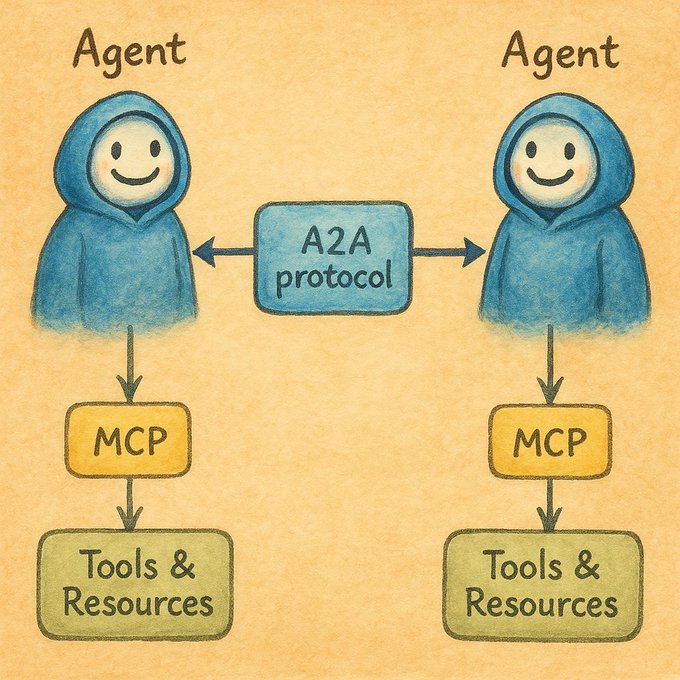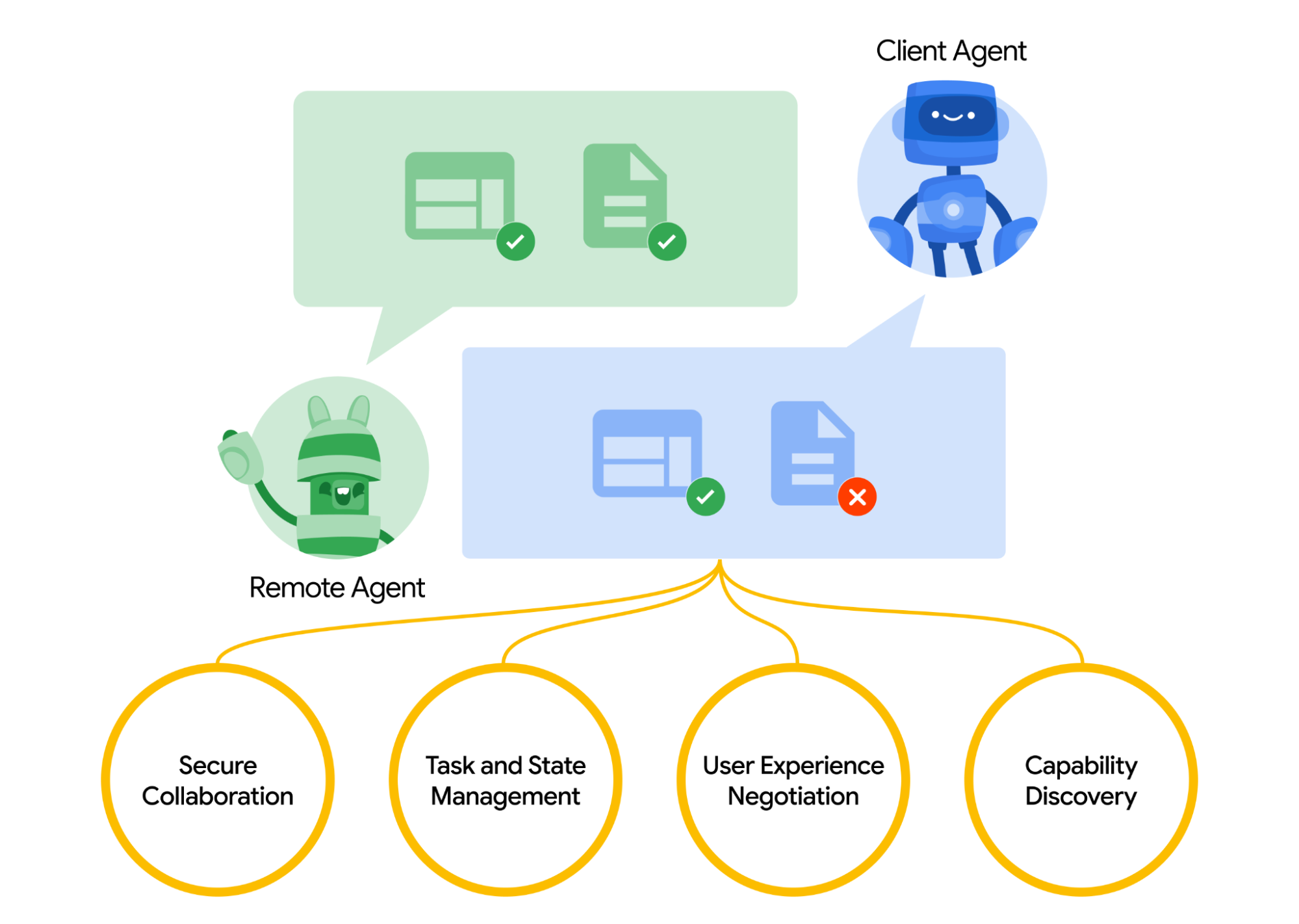
Modern AI systems look less like single models and more like distributed ecosystems, with some components retrieving data, others taking action, and others collaborating to solve problems. In that environment, two technologies often appear together even though they sit on different layers of the architecture: Model Context Protocol (MCP) and Agent-to-Agent (A2A).
MCP was introduced by Anthropic in November 2024 as an open-standard protocol designed to enable models to interact with external tools and data sources. A2A was announced by Google in April 2025 to serve as a protocol for agent-to-agent communication and collaboration. Both expand what AI systems can accomplish, but each addresses a distinct engineering need and operates with a different set of responsibilities.

Although these technologies often show up in the same system diagrams, their roles are complementary rather than interchangeable. MCP operates at the boundary between an AI model and the external world, providing a standardized interface for safe, structured tool use. MCP is essentially the universal power outlet for AI systems, giving a model one reliable way to plug into the tools and data sources it needs without rewiring everything each time. A2A is more like a team communication platform, giving agents a shared space to talk, plan, and hand work to each other just as coworkers would in a group project.
Why MCP and A2A Matter in Modern Architectures
Once an AI system grows beyond basic prompt-in and answer-out patterns, the architectural challenges shift. Models begin depending more on external data, specialized tools, background processes, and other autonomous components. Without clear frameworks governing how these pieces interact, even a well-designed system can become fragile or sluggish. MCP and A2A supply the scaffolding that allows these moving parts to operate in a deliberate, predictable way.
MCP
Without MCP, each tool in the system becomes a bespoke integration with its own assumptions, authentication scheme, error patterns, and data shapes. Over time these one-off connectors accumulate into a tangle of fragile interfaces that break whenever a model changes, a library updates, an API parameter is deprecated, or a tool evolves. The absence of a unifying protocol can also lead to overly broad permissions since developers are oftentimes under the gun to get something to production yesterday. MCP helps prevent this drift by standardizing how models discover tools, validate inputs, and exchange data. Instead of stitching together ad hoc pathways, developers gain a consistent contract that keeps boundaries clean, integrations maintainable, and the overall system far easier to upgrade safely.

It plays the role of an adapter any Macbook user can’t live without. It essentially ensures that all participating tools—no matter how idiosyncratic—plug into the model through a single, predictable interface. Instead of crafting a new connector for each service, developers expose capabilities the same way a universal hub exposes ports: The model only needs to understand one shape of interaction, while the adapter handles the translation behind the scenes. This keeps tool diversity from collapsing into architectural complexity. A CRM system, calendar provider, file repository, or proprietary internal service might all look different under the hood, but once they are presented through MCP they behave like interchangeable modules, allowing the model to communicate through a stable contract while the adapter does the heavy lifting. This makes the system far more resilient as tools, vendors, and requirements change.
A2A
Similarly, without A2A, each agent tries to communicate through improvised message formats and informal handoff patterns, which can lead to collisions, duplicated effort, and ambiguity about which agent is responsible for what. As more agents enter the system, the absence of shared rules can make coordination increasingly unstable. They may interrupt each other, enter unproductive loops, or escalate tasks prematurely because there is no agreed-upon structure guiding their behavior. A2A resolves these coordination hazards by giving agents a common language and predictable interaction patterns, even when those agents originate from entirely different providers. It brings order to the collaboration layer, allowing agents to negotiate tasks, refine reasoning, and converge on outcomes with far greater reliability than ad hoc messaging ever allows.

A2A enforces this structure by defining a clear relationship between the agent that requests work and the agent that performs it. The client agent frames the task, expresses what it needs, and shares the relevant context, while the remote agent interprets that request and responds with progress updates, results, or clarifying messages. To make this possible, each agent advertises the capabilities it can offer, allowing the client to determine whether it is the right partner for a given task. Once the exchange begins, both sides operate within a shared task model that tracks status, intermediate outputs, and final results. This gives long-running or multi-step processes a stable lifecycle instead of a loosely stitched sequence of messages.
A2A also supports negotiation about formats, content types, and user interface constraints, ensuring the agents can agree on how information should be exchanged. The diagram reflects this choreography: one agent signals what it can do, the other evaluates and initiates a task, and both stay in sync through structured communication that keeps collaboration coherent even when the agents differ in origin, design, or capabilities.
Better Together
Let’s bring this down into the nitty gritty with a real-world example use case.
Imagine an appliances company, which sells smart home devices and supports more than three million customers. We’ll call it Acme Appliances. Clever, I know.
Problem: Long Resolution Times
Let’s say their support team struggles with long resolution times because information is scattered across different systems. Troubleshooting data lives in a product telemetry database, customer history lives in a CRM, warranty eligibility sits in a separate legacy system, and fulfillment requests go through an internal operations API.
Leadership Ask: Use AI to Add Efficiency
Leadership wants an AI-driven workflow that reduces handoffs and accelerates resolution, but developers know that stitching these systems together manually will be brittle, expensive, and difficult to maintain.
Solution: 3 Agents + MCP Swiss Army Knife
They begin by deploying three specialized agents:
- A triage agent that interprets customer issues
- A diagnostics agent that analyzes device logs and sensor data
- A fulfillment agent that handles replacement units, technician scheduling, or warranty approvals
A2A becomes the backbone for how these agents collaborate. When a customer writes in about a malfunctioning air purifier, the triage agent initiates a task, summarizes the complaint, and evaluates which agent is best suited to lead the next step. Through A2A capability discovery, it determines that the diagnostics agent can ingest sensor readings and analyze failure patterns, so it passes the task along. The diagnostics agent works within the A2A task lifecycle, sending progress updates, sharing intermediate findings, and requesting clarification when needed.
To perform its work, however, the diagnostics agent needs access to several internal systems. This is where MCP comes in. Instead of developers writing one-off integrations into Acme’s telemetry platform, CRM, and warranty system, they expose each through an MCP server.
The diagnostics agent uses MCP to securely fetch the device’s last 48 hours of air-quality readings, error logs, filter health status, and firmware version. Since MCP handles schemas and validates inputs, the agent does not need to know how each internal system is implemented. Once the diagnostics agent identifies a failing particulate sensor, it sends the result back to the triage agent via A2A, which in turn forwards the task to the fulfillment agent. The fulfillment agent then uses MCP to check warranty status and schedule a replacement shipment using Acme’s internal logistics API.
With A2A orchestrating the reasoning and handoffs, and MCP providing clean, permissioned access to the company’s fragmented systems, Acme Appliances achieves a tech stack that behaves like a coordinated team rather than a scattered set of tools. The agents collaborate predictably, the integrations remain maintainable, and the entire workflow becomes far more resilient to internal system changes—exactly the kind of architecture modern enterprises are moving toward.
Image credit: Dima Pechurin
Leave a Reply